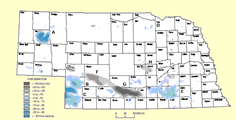Natural Resources, School of

Conservation and Survey Division: Faculty and Staff Publications
Document Type
Article
Date of this Version
2015
Citation
Allen-King, R. M., I. Kalinovich, D. F. Dominic, G. Wang, R. Polmanteer, and D. Divine (2015), Hydrophobic organic contaminant transport property heterogeneity in the Borden Aquifer, Water Resour. Res., 51, 1723–1743, doi:10.1002/2014WR016161.
Abstract
We determined that the spatial heterogeneity in aquifer properties governing the reactive transport of volatile organic contaminants is defined by the arrangement of lithofacies. We measured permeability (k) and perchloroethene sorption distribution coefficient (Kd) for lithofacies that we delineated for samples from the Canadian Forces Base Borden Aquifer. We compiled existing data and collected 57 new cores to characterize a 30 m section of the aquifer near the test location of Mackay et al. (1986). The k and Kd were measured for samples taken at six elevations from all cores to create a data set consisting of nearly 400 colocated measurements. Through analysis of variance (corrected for multiple comparisons), we determined that the 12 originally mapped lithofacies could be grouped into five relatively distinct chemohydrofacies that capture the variability of both transport properties. The mean of ln k by lithofacies was related to the grain size and the variance was relatively consistent. In contrast, both the mean and variance of ln Kd were greater for more poorly sorted lithofacies, which were also typically more coarse-grained. Half of the aquifer sorption capacity occurred in the three highest-sorbing lithofacies but comprised only 20% of its volume. The model of the aquifer that emerged is that of discontinuous scour-fill deposits of medium sand, generally characterized by greater Kd and k, within laterally extensive fine-grained to very fine-grained sands of lower Kd and k. Our findings demonstrate the importance of considering source rock composition, transport, and deposition processes when constructing conceptual models of chemohydrofacies.
Text S1, Figures S1 to S9, Tables S1, S4-S5, Captions and headings for Tables S2 and S3
Divine WRR 2015 Hydrophobic organicSUPPL2.txt (417 kB)
Table S2. Indicator data. The column headings are in Suppl 1
Divine WRR 2015 Hydrophobic organicSUPPL3.txt (16 kB)
Table S3. The k and Kd results, and unit, by core and sample number for the data set presented in this manuscript. Data. Column heads in Suppl 1.
Included in
Geology Commons, Geomorphology Commons, Hydrology Commons, Paleontology Commons, Sedimentology Commons, Soil Science Commons, Stratigraphy Commons


Comments
Copyright 2015. American Geophysical Union. Used by permission.